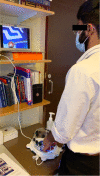Validating low-fidelity arthroscopic simulation in medical students: a feasibility trial
- PMID: 35446721
- PMCID: PMC9773295
- DOI: 10.1308/rcsann.2022.0008
Validating low-fidelity arthroscopic simulation in medical students: a feasibility trial
Abstract
Introduction: With surgical opportunities becoming increasingly restricted for orthopaedic trainees, simulation training is a valuable alternative at providing sufficient practice. This pilot study aims to assess the potential effectiveness of low-fidelity simulation in teaching medical students basic arthroscopic skills and the feasibility of its incorporation into formal student training programmes.
Methods: Twenty-two medical students completed pre- and post-training tests on the Probing (Task 1) and Maze (Task 2) exercises from the Sawbones 'Fundamentals of Arthroscopy Surgery Training' (FAST) programme. Training consisted of practising horizon control, deliberate linear motion and probing within 25min over a period of days. Completion time and error frequency were measured. The difference in performance was assessed using a paired two-tailed t-test. Qualitative data were collected.
Results: Test completion time decreased significantly by a mean of 83s (±46s, 95% confidence intervals [CI] 37 to 129) for Task 1 (p=0.001) and 105s (±55s, 95% CI 50 to 160) for Task 2 (p=0.0007). Frequency of direct visualisation errors decreased significantly by a mean of 1.0 errors (±1.0 errors, 95% CI 0.1 to 2.0) for Task 1 (p = 0.04) and 0.8 errors (±0.8 errors, 95% CI 0.1 to 1.6) for Task 2 (p = 0.04). At post-training, 82% of participants were willing to incorporate FAST into formal training.
Conclusions: Low-fidelity simulators such as FAST can potentially teach basic arthroscopic skills to medical students and are feasible for incorporation into formal training. They also give students a cost-effective and safe basic surgical training experience.
Keywords: Arthroscopy; Orthopaedic procedures; Orthopaedics; Simulation training.
Figures








Similar articles
-
Does Arthroscopic Simulation Training Improve Triangulation and Probing Skills? A Randomized Controlled Trial✰.J Surg Educ. 2019 Jul-Aug;76(4):1131-1138. doi: 10.1016/j.jsurg.2019.01.008. Epub 2019 Mar 4. J Surg Educ. 2019. PMID: 30846347 Clinical Trial.
-
Virtual Reality Compared with Bench-Top Simulation in the Acquisition of Arthroscopic Skill: A Randomized Controlled Trial.J Bone Joint Surg Am. 2017 Apr 5;99(7):e34. doi: 10.2106/JBJS.16.00324. J Bone Joint Surg Am. 2017. PMID: 28375898 Clinical Trial.
-
Construct Validity, Assessment of the Learning Curve, and Experience of Using a Low-Cost Arthroscopic Surgical Simulator.J Surg Educ. 2017 Jan-Feb;74(1):47-54. doi: 10.1016/j.jsurg.2016.07.006. Epub 2016 Oct 5. J Surg Educ. 2017. PMID: 27720405
-
Utility of Modern Arthroscopic Simulator Training Models: A Meta-analysis and Updated Systematic Review.Arthroscopy. 2018 May;34(5):1650-1677. doi: 10.1016/j.arthro.2017.10.048. Epub 2018 Jan 20. Arthroscopy. 2018. PMID: 29366742
-
The role of virtual reality in knee arthroscopic simulation: a systematic review.Musculoskelet Surg. 2023 Mar;107(1):85-95. doi: 10.1007/s12306-021-00732-9. Epub 2021 Oct 15. Musculoskelet Surg. 2023. PMID: 34655024
Cited by
-
UK foundation trainee perceptions of surgical skills in the foundation training programme - a national survey.Int J Surg Protoc. 2024 Nov 22;29(1):1-5. doi: 10.1097/SP9.0000000000000034. eCollection 2025 Dec 21. Int J Surg Protoc. 2024. PMID: 40453190 Free PMC article.
-
When teaching procedures in simulation, do simulation adjuncts translate to better performance?Adv Simul (Lond). 2025 Jul 1;10(1):36. doi: 10.1186/s41077-025-00365-z. Adv Simul (Lond). 2025. PMID: 40598666 Free PMC article.
References
-
- Hartle A, Gibb S, Goddard A. Can doctors be trained in a 48 hour working week? BMJ 2014; 349: g7323. - PubMed
-
- Inaparthy P, Sayana M, Maffulli N. Evolving trauma and orthopedics training in the UK. J Surg Educ 2013; 70: 104–108. - PubMed
-
- Price A, Erturan G, Akhtar Ket al. . Evidence-based surgical training in orthopaedics. Bone Joint J 2015; 97-B: 1309–1315. - PubMed
-
- Luzzi A, Hellwinkel J, O’Connor Met al. . The efficacy of arthroscopic simulation training on clinical ability: a systematic review. Arthrosc – J Arthrosc Relat Surg 2020; 37: 1000–1007. - PubMed
MeSH terms
LinkOut - more resources
Full Text Sources

